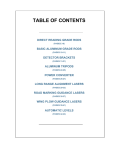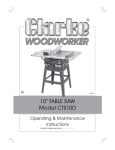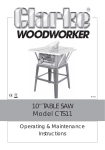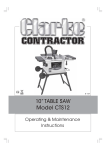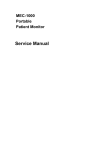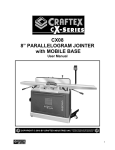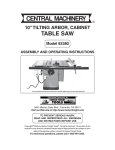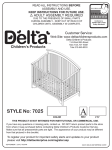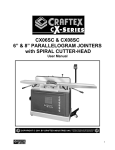Download Clarke CTS10D Instruction manual
Transcript
© 0900 10” TABLE SAW Model CTS10C Part Number 6500750 Operating & Maintenance Instructions PRODUCT SERIAL/BATCH NO............................ 1 Thank you for purchasing your new CLARKE 10” TABLE SAW, which is designed for DIY, and hobby use ONLY. Before attempting to operate this machine, please read this instruction manual thoroughly and follow all directions carefully. In doing so you will ensure the safety of both yourself and others around you, and, at the same time, you should look forward to it providing long and trouble free service. GUARANTEE This product is guaranteed against faults in manufacture for 12 months from purchase date. Keep your receipt as proof of purchase. This guarantee is invalid if the product has been found to have been abused in any way, or not used for the purpose for which it was intended, or to have been tampered with in any way. The reason for return must be clearly stated. This guarantee does not affect your statutory rights. CONTENTS Specifications ............................................................................................. 3 General Safety Rules .................................................................................. 4 Additional Safety Rules for Table Saws .................................................... 5 Electrical Connections ............................................................................... 6 Features ....................................................................................................... 7 Glossary of Terms ........................................................................................ 8 Unpacking and Checking Contents ........................................................ 9 Assembly Instructions .............................................................................. 10 Mounting the Saw ..................................................................................... 12 Important Checks before Starting .......................................................... 13 Operating Instructions ............................................................................. 15 Starting & Stopping .................................................................... 15 Rip Cutting .................................................................................. 15 Cross Cutting .............................................................................. 18 Repetitive Cutting ...................................................................... 19 Mitre Cutting ............................................................................... 20 Bevel Cross Cutting .................................................................... 20 Compound Mitre Cutting .......................................................... 21 Maintenance ............................................................................................ 21 Changing the Saw Blade .......................................................... 22 Saw Blade Adjustments ............................................................. 22 Trouble Shooting ....................................................................................... 24 Parts Lists and Diagrams .................................................................... 25-27 2 SPECIFICATIONS Model No .............................................. CTS10C Part No. .................................................. 6500750 Motor ..................................................... 230V~ 50Hz 1ph Power rating .............................. 1.4Kw Speed ........................................ 4800 rpm Fuse rating ................................. 13Amps Saw Blade ............................................. 10” dia. - 5/8” bore (254x16mm) TCT Maximum depth of cut ........................ 75mm Weight ................................................... 20.5KG Noise level at operating position ........ 99dB LWA (Cutting 50mm soft wood) Table dimensions .................................. 660x430mm (26”x17”) Use of machine This machine is designed to rip and cross cut wood exclusively, up to a maximum thickness of 75mm. For correct operation it must be fixed and operated as laid down in this manual. This saw is intended for DIY, and hobby use ONLY. Restrictions of use This saw is NOT suitable for cutting: • • Timber greater than 75mm in thickness. • Logs or round timber. Metal, Stone, Rubber, Plastic, Bones, Etc. DO NOT use to rebate, tenon, mould or groove. DO NOT fit any other tool or combination of blades. DO NOT use as a free standing machine or as a hand held machine. DO NOT modify the machine or its guards/controls in any way. DO NOT use with any covers/guards removed. 3 GENERAL SAFETY RULES WARNING! As with all machinery, there are certain hazards involved with their operation and use. Exercising respect and caution will considerably lessen the risk of personal injury. However, if normal safety precautions are overlooked or ignored, personal injury to the operator or damage to property may result. 1. READ AND BECOME FAMILIAR with the entire operating manual. Learn the machine’s applications and limitations as well as the specific potential hazards peculiar to it. 2. CHECK DAMAGED PARTS. Before using the machine, check to ensure that a guard or other damaged part, will operate properly and perform its intended function. Check for alignment of moving parts, breakage of parts, mountings, or any other conditions that may affect its operation. A guard or other part that is damaged should be properly repaired or replaced. 3. REMOVE TOOLS BEFORE SERVICING and when changing accessories such as blades, fences etc. 4. ALWAYS KEEP GUARDS in place and in working order. 5. ALWAYS USE SAFETY GOGGLES. Also use face or dust mask if cutting operation is dusty. REMEMBER, everyday eyeglasses do not have impact resistant lenses, they are NOT safety glasses. 6. KEEP WORK AREA CLEAN. Cluttered areas and benches invite accidents. 7. WEAR EAR PROTECTORS/DEFENDERS. 8. DO NOT FORCE THE MACHINE. It will do a better and safer job at the rate for which it was designed. 9. REMOVE ADJUSTING KEYS AND SPANNERS. Form the habit of checking to see that keys and adjusting spanners etc., are removed from machine before turning it on. 10. ALWAYS feed the work into the blade against direction of rotation only. 11. DRUGS, ALCOHOL, MEDICATION. Do not operate machine whilst under the influence of drugs, alcohol or any medication. 12. USE RECOMMENDED ACCESSORIES. The use of improper accessories could be hazardous. 13. NEVER STAND ON THE MACHINE. Injury could occur from a fall. 14. NEVER LEAVE MACHINE RUNNING UNATTENDED. Turn power OFF. Don’t leave machine until it comes to a complete stop. 15. ALWAYS DISCONNECT THE PLUG from electrical outlet when adjusting, changing parts or working on the machine. 16. AVOID DANGEROUS ENVIRONMENT. Don’t use power tools in damp or wet locations or expose them to rain. Keep your work area well illuminated. DO NOT USE in explosive atmosphere (around paint, flammable liquids etc.). 17. KEEP CHILDREN AWAY. All visitors should be kept a safe distance from work area, especially whilst operating the machine. 18. MAINTAIN BLADE and ACCESSORIES IN TOP CONDITION. Keep blade sharp and clean for best and safest performance. Follow instructions for lubricating and changing accessories. 4 19. SECURE THE WORK. Use clamps to hold accessories when practical. It’s safer than using your hand. 20. DON’T OVERREACH. Keep your proper footing and balance at all times. For best footing wear rubber soled shoes or boots. Keep the floor clear of oil, scrap wood, etc. 21. WEAR PROPER APPAREL. Loose clothing or jewellery may get caught in moving parts. Wear protective hair covering to contain long hair. 22. MAKE WORKSHOP CHILDPROOF. Lock the saw away, or cover securely when not in use. ADDITIONAL SAFETY RULES FOR TABLE SAWS ✔ ALWAYS use saw Blade Guard, Riving Knife and Antikickback Pawls for every operation. ✔ ALWAYS hold the work firmly against the mitre gauge or fence. ✔ ALWAYS use a push-stick when required. Always use a push-stick for ripping narrow stock. Refer to ripping applications in instruction manual where push-stick is covered in detail. ✔ ALWAYS use in a well ventilated area. Remove sawdust frequently. Clean out sawdust from the interior of the saw to prevent a potential fire hazard. ✔ ALWAYS move the rip fence out of the way when crosscutting. ✔ ALWAYS switch off and disconnect from supply before removing off cuts of wood from the machine ALWAYS provide adequate support to the rear and sides of the saw table for wide or long workpieces. ✔ ALWAYS keep the blade sharp, the rip fence parallel to the saw blade, the Riving Knife, anti-kickback pawls and guard in place to avoid kickbacks (work thrown back toward you). Do not release work before it is pushed all the way past the saw guide along the fence. ✔ ALWAYS avoid awkward operations and hand positions where a sudden slip could cause your hand to move into the cutting tool. ✔ PERMANENTLY mount your table saw before performing any cutting operations. Refer to ‘Mounting the Saw’ on page 12. ✘ NEVER stand or have any part of your body in line with the path of the saw blade. Keep your hands out of the line of the saw blade. ✘ NEVER reach behind or over the blade for any reason. ✘ NEVER use the fence as a cutoff gauge when crosscutting. ✘ NEVER attempt to free a stalled saw blade without first turning the saw OFF. Turn off power switch immediately to prevent motor damage. ✘ NEVER use solvents to clean plastic parts. Solvents could possibly dissolve or otherwise damage the material. Only a soft damp cloth should be used to clean plastic parts. ✘ NEVER force feed the work into the blade. A light pressure ONLY is required ✘ NEVER cut metals or materials which may make hazardous dust. ✘ NEVER perform any operation ‘freehand’ which means using your hands to support or guide the work piece. Always use either the fence or the mitre gauge to position and guide the work. 5 ELECTRICAL CONNECTIONS WARNING! THIS APPLIANCE MUST BE EARTHED. Connect the mains lead to a 230 volt (50Hz) domestic electrical supply via a standard 13 amp BS 1363 plug fitted with a 13 amp fuse, or a suitably fused isolator switch. IMPORTANT: The wires in the mains lead are coloured in accordance with the following code: Green & Yellow - Earth Blue - Neutral Brown - Live As the colours of the flexible cord of this appliance may not correspond with the coloured markings identifying terminals in your plug, proceed as follows: Connect GREEN & YELLOW coloured cord to plug terminal marked with a letter “E” or Earth symbol “ ”, or coloured GREEN or GREEN & YELLOW. Connect BROWN coloured cord to plug terminal marked letter “L” or coloured RED. Connect BLUE coloured cord to plug terminal marked letter “N” or coloured BLACK. We strongly recommend that this unit is connected to the mains supply via a Residual Current Device (RCD). IMPORTANT! If this appliance is fitted with a plug which is moulded onto the electric cable (i.e. non- rewirable) please note: 1. The plug must be thrown away if it is cut from the electric cable. There is a danger of electric shock if it is subsequently inserted into a socket outlet. 2. Never use the plug without the fuse cover fitted. 3. Should you wish to replace a detachable fuse carrier, ensure that the correct replacement is used (as indicated by marking or colour code). 4. Replacement fuse covers can be obtained from your local dealer or most electrical stockists. Fuse Rating The fuse in the plug must be replaced with one of the same rating (13 amps) and this replacement must be ASTA approved to BS1362. Extension Cable If an extension cable is fitted, ensure the minimum cross section of the conductor is 1 .5mm2 for up to 15 metres in length, and 2.5mm2 for up to 25 metres. WARNING: If the power cable is worn or cut, or damaged in any way, have it replaced immediately to avoid shock or fire hazard. 6 FEATURES Blade Guard Riving Knife Table Insert Fig.1 Rip Fence Mitre Gauge Table Switch Panel Dust Extraction Outlet Mounting Hole Blade height Adj Wheel Blade tilt Scale Blade Tilt Locking Knob 1. The switch panel incorporates the ON and OFF switches, and an overload reset button. Your saw also features an Overload Protection device, so that if the motor is overloaded (due to feed pressure being too great, dull blade or low voltage), the Overload Relay will intervene, and the motor will automatically cut out. 2. A Dust Extraction Outlet is provided at the rear of the machine. A vacuum extractor with a suitable flexible hose (40mm dia.), may be connected and used either permanently or intermittently as required. 3. The Table is provided with two slots, one each side of the saw blade, running across its entire depth. These slots are for use with the Mitre Gauge when cross cutting, either square or mitres, and is explained under ‘Operation’. A scale on the Mitre Gauge indicates the angle at which the workpiece is being mitred. 4. Four holes are provided in the base so that the saw may be bolted to a workbench or stand. Please note that the machine MUST be firmly secured to either a workbench or a support to ensure its complete stability. This is explained in detail under ‘Mounting the Saw on page 12. 5. The Blade Height Adjuster Wheel raises or lowers the blade. Additionally, when pushed IN against spring pressure, and the Blade Tilt Locking Handle is released, it may be turned to tilt the blade to any desired angle (see below). 6. The Blade Tilt Locking Knob, when slackened, allows the saw blade to be tilted to any desired angle from 0O to 45O , as shown on the Blade Tilt Scale. This may be done manually, by grasping the Locking Knob, when it is slackened, and carefully moving the blade assembly, or by pushing the Blade Height Adjuster Wheel IN against spring pressure, so that a set of gear teeth engage, and then turning the wheel to power the blade to your desired angle. The Blade is locked in position by tightening the Blade Tilt Locking Knob. 7 7. The Rip Fence is for use when rip cutting timber. It can be easily moved or locked in place by screwing IN the locking handle. Take care NOT to overtighten the locking handle. 8. The Blade Guard protects the operator and must ALWAYS be in place and working properly. IMPORTANT: This machine IS NOT designed for ‘non-through cutting’ operations 9. Anti-Kickback Pawls are attached to the blade guard bracket, which, when properly maintained, are designed to stop the workpiece from being kicked back at the operator during operation. WARNING! NEVER USE MACHINE WITH THE BLADE GUARD REMOVED. 10. The Table Insert is removable to facilitate the installation or removal of the saw blade, and must ALWAYS be in place. GLOSSARY OF TERMS Arbor The shaft on which a cutting tool is mounted. Crosscut A cutting or shaping operation made across the width of the workpiece across the grain. Featherboard A device which can help guide workpieces during rip type operation. Freehand Performing a cut without a fence, mitre gauge, fixture, hold down or other proper device to keep the workpiece from twisting during the cut. Heel Misalignment of the blade. Kerf The amount of material removed by the blade in a through cut. Kickback An uncontrolled grabbing, and throwing of the workpiece back toward the front of the saw during a rip type operation. Leading End The end of the workpiece which, during a rip type operation, is pushed into the cutting tool first. Push Stick A device used to feed the workpiece through the saw during narrow ripping type operation and which helps keep the operator’s hands well away from the blade. Push Block A device used for ripping type operations too narrow to allow use of a push stick. Rabbet A notch in the edge of a workpiece. Resin A sticky, sap base substance that has hardened. Ripping A cutting operation along the length of the workpiece - in the direction of the grain. Riving Knife Positioned behind the saw blade to prevent wood closing and jamming after being cut. 8 UN-PACKING AND CHECKING CONTENTS The Table Saw is shipped complete in one carton. Separate all parts from the packing materials and check to ensure that all components are accounted for, according to the following list, before discarding any packing material. Should any component be missing or damaged in transit, please contact your CLARKE dealer immediately, or CLARKE Customer Service Department on 020 8556 4443. B Table of parts A Table Saw Assembly. B Saw Blade. A C Mitre Gauge Assy. D Blade Guard Assy., c/w bracket and anti-kickback pawls. C E Rip Fence (Without Handle). F Push Stick. D E Loose parts in bags F G Arbor Spanner. H Saw Blade Securing Nut Spanner I Handle (for Blade Height Adjuster Wheel) complete with M6 x55mm Cross Head Screw and M6 Hex Nut H G I B J Handle (Rip Fence) K K Hex Bolt M6x55mm, Flat Washer and Lockwasher (External Shakeproof) Tools Needed for Assembly 1. Combination Square - Must Be True (Check as shown opposite) 2. Phillips Screwdriver 3. Medium Screwdriver 4. 10mm Spanner Straight edge of board 19mm (3/4”) thick, this edge must be perfectly straight. Should be no gap or overlap here when square is flipped over in dotted position. 9 Checking Straight Edge with Comb. Square ASSEMBLY Before the machine can be used, the loose parts must first be assembled to it, and certain adjustments carried out. Please proceed as follows: A. The Saw Blade WARNING! EXERCISE EXTREME CARE WHEN HANDLING THE SAW BLADE. THE TEETH ARE EXTREMELY SHARP AND CARELESSNESS COULD CAUSE SEVERE PERSONAL INJURY. 1. Turn Blade height adjuster handwheel anticlockwise until the arbor is up as high as it will go, remove the two Table Insert screws and lift the table insert out of the recess in the table. 2. Place the open end arbor spanner on the flats on the inner flange to prevent the arbor from rotating, and remove the blade securing nut using the spanner provided. Remove the outer flange. 3. Manoeuvre the blade gently through the slot in the table, so as not to damage the teeth, and mount it on the arbor, ensuring the TEETH OF THE BLADE ARE POINTING DOWN AT THE FRONT OF THE TABLE. 4. Replace the outer flange, followed by the blade securing nut, and tighten securely. 5. Replace the table insert, in the recess in the table, and secure in place. Ensure the blade rotates truly and freely - by hand. B. Blade Guard and Bracket Assembly 1. Fig.2 From among the loose parts, locate the following: External shakeproof washer 1.1 1 x Hex bolt (M6x55mm) Flat washer 1.2 2 x Flat washers (6mm) 1.3 2 x Lockwashers (1 x external shakeproof and 1 x internal shakeproof - 6mm) Blade Guard Bracket Flat washer Internal shakeproof washer 1.4 1 x Blade Guard Support Bracket complete with Blade Guard and anti-Kickback Pawls. 2. The mounting for the Blade Guard Bracket is at the rear centre of the table. Thread the bolt with the flat and shake- proof washers in place, as shown opposite, through the slotted hole in the bracket support, and into the mounting hole (Fig.2). 3. Using a straight edge, check to ensure the Guard bracket is correctly aligned with the saw blade (Fig.3). If an adjustment is necessary, the guard bracket can be moved left or right, and rotated. When you are certain it is properly aligned with the e saw blade, tighten the securing bolt fully. 10 Blade Guard Bracket Support Bolt Fig.3 Straight Blade Guard edge Riving Knife bracket Blade Guard Blade Guard Support WARNING! NEVER START THE MACHINE WITH THE BLADE GUARD REMOVED. C. Rip Fence 1. Remove and discard the shipping nut from the threaded rod on the front end of the fence clamp bracket and thread the fence locking handle on to the threaded rod. 2. Place the fence on the table. Hold the plastic casting, on front of the rip fence, firmly against the front edge of the table and tighten the lock handle securely. DO NOT overtighten the handle, as this will damage the plastic front block. NOTE: Holes are provided in the rip fence for attaching a wood facing if required. Fig.4 Select a piece of smooth straight wood, approx. 19mm (3/4”) thick and the same size as the rip fence. Attach it to the fence with two round head No.10 wood screws 40mm long. Wood facing If you are making a rip type cut in thinner materials, the facing should be attached to the fence so that the bottom edge touches the top surface of Screw IN lock handle to secure Rip Fence the table. In this situation, the facing must be lower than the fence, i.e. flush with the table. This will prevent thin material from sliding under the rip fence. D. Handle (to Blade Height Adjuster Handwheel) 1. Locate the following loose parts: Fig.5 1 x M6 x 55mm Cross Head Screw 1 x 6mm nut 1 x Small Plastic handle 2. Thread the screw through the hole running through the handle and screw on the locknut as far as it will go, as shown in the diagram. Then screw the assembly into the rim of the Blade Height Adjuster handwheel until the plastic handle tightens. Back off the screw slightly and unscrew the nut until it is tight against the rim of the handwheel, thereby locking the screw in that position. When properly assembled, the handle will rotate freely about the screw, with minimal end play. Your Table Saw is now fully assembled. However, before it can be used, you must ensure that it is securely and correctly mounted, and checks MUST be made to ensure that all necessary adjustments are correct, and that parts are properly aligned. These details are covered in the following paragraphs. 11 MOUNTING THE SAW IMPORTANT If the saw is to be a permanent fixture, ensure it is sited in an area with adequate illumination and power supply. DO NOT place it where you will be working in your own shadow, or where extension cables are required - these are hazardous in a workshop environment. If the table saw is to be used in a permanent location, it should be fastened securely to a firm supporting surface such as a stand or workbench, using the four mounting holes in the base. A Floor Stand, specially designed for your CTS10C Table Saw is available from your CLARKE dealer . Dimensions of the opening are shown in Fig.6. opening in bottom of saw Fig.6 330mm (13”) If a VACUUM DUST EXTRACTION device is NOT to be used, an opening MUST also be made in the workbench, the same size as the opening in the bottom of the saw. (which houses the Bottom Grid). This is in order to allow the saw dust to drop through. 419mm (16.5”) 286mm (11.25”) Holes should be drilled through the supporting surface of the workbench using the dimensions illustrated and the machine should be bolted down firmly. 305mm (12”) Mounting Holes IMPORTANT Ensure the Bottom Grid is in place when bolting the machine to the workbench. 1. Each of the four mounting holes should be bolted securely using 8mm bolts (not included) which should be 12mm longer than the thickness of the bench top. 2. Locate and mark where the saw is to be mounted. 3. Drill four (4) 10mm diameter holes through workbench. 4. Place table saw on workbench aligning the holes in the base with the holes drilled in the workbench. 5. Insert four (4) 8mm bolts and tighten. Mounting to Plywood An alternative method of securing your table saw is to fasten the saw base to a mounting board, 600x600mm minimum size, to prevent the saw from tipping whilst in use. A good grade of plywood with a minimum thickness of 19mm is recommended. 1. Follow the instructions for mounting to a workbench, substituting a plywood board with a minimum size of 600x600mm. The opening in the board should be the same as that shown in the diagram above. To secure the table saw to the plywood board use 8mm countersunk screws with lock washers and hex nuts (not included). Screw length must be at least 12mm more than the thickness of the mounting board. 12 NOTE: For proper stability, holes must be counter sunk on the underside of the plywood so that screw heads are flush with the bottom surface of the mounting board. IMPORTANT Ensure the Bottom Grid is in place when bolting the machine to the workbench. 2. Securely clamp the board to a workbench using two or more “G” clamps, as illustrated in Fig. 7. The supporting surface, where saw is to be mounted, should be examined carefully after mounting to ensure that no movement can occur during use. If any tipping or creeping is noted, it should be investigated and rectified. The mounting surface must be flat and even. Fig.7 IMPORTANT CHECKS - BEFORE STARTING IMPORTANT: Before attempting to use the machine, it is necessary to ensure the various components are correctly adjusted, and checked for security. 1. The Riving Knife The Riving Knife is essential in producing a good clean cut without chattering or binding taking place. This adjustment is critical and must ALWAYS be checked before starting your machine. To adjust the riving knife remove the Bottom Cover to give access to the riving knife mounting bolts. (The Bottom cover is secured with four self tapping screws, one in each corner). Fig.8 Slacken off the Riving Knife mounting bolts and adjust the knife so that a MAX. clearance of 15mm is maintained around the entire length of the knife, as shown in Fig.8. Check to ensure the riving knife is straight and directly in line with the blade, and in the middle of the cut (KERF) made by the saw blade, as shown in Fig .9 on page 14. NOTE: The riving knife is thinner than the width of the KERF. Should the Riving Knife become out of shape or misaligned, it must be gently eased back into line, or if the damage is more severe, it must be removed and bent back into shape accordingly, or replaced. 13 2. The Saw Blade Fig.9 Check to ensure the blade is sound. If teeth are chipped, or cracks are apparent, it must be renewed. Blade Blade Guard Kerf Riving Knife Bracket 3. The Blade Guard Ensure the Blade Guard is in place, pivots freely, and falls under its own weight. No further adjustments should be necessary, but before you proceed to use the machine, it is recommended that you apply a coat of paste wax to the table to reduce friction when pushing the workpiece across the table. Wipe the table thoroughly with a clean dry cloth. HELPFUL HINTS Work Helpers Before cutting any wood on your saw, study all of the Basic Saw Operations. Notice that in order to make some of the cuts, it is necessary to use certain devices, -’Work Helpers’, such as the Push Stick, the Push Block and the Auxiliary Fence, all of which you can make yourself. After you have made a few practice cuts, make up these ‘helpers’ before starting any projects. Push Stick and Push Block Fig.10 Make the Push Block using pieces of 10mm plywood and 19mm hardwood as shown in Fig.10. 127mm 304mm 130mm 120mm The small piece of wood 10x10x64mm should be GLUED to the plywood. DO NOT USE NAILS or SCREWS. This is to prevent damaging the saw blade in the event you mistakenly cut into the push block. Position the handle in the centre of the plywood and fasten together with glue and wood screws screwed in from below. (Ensure the screw holes are countersunk. The screw heads must not be proud). 10mm 19mm 64mm 10mm Fig.11 19mm 40mm 380mm 45° x 45° notch Replacement Push Sticks can be made using a suitable piece of timber as shown in Fig. 11. 6 x 6mm 14 Auxiliary Fence 445mm 120mm Make one using pieces of 10mm plywood and 19mm hardwood. Fasten together with glue and wood screws. Dimensions are shown in Fig. 12. 44mm 19mm 10mm NOTE: Since the Push Block is used with the Auxiliary Fence, the 120mm dimensions must be held identical on both the pieces. Auxiliary Fence Fig.12 OPERATION 1. Starting and Stopping the Machine The ON and OFF switches are located on the front left of the machine. The upper, GREEN switch is the ON switch and is marked with an ‘I’ symbol. The lower, RED switch is the OFF switch. It is raised and marked with the symbol ‘O’. For additional safety, the ON switch is a ‘NO VOLT RELEASE’ type. This means that if the power is interrupted for whatever reason whilst the machine is switched ON, the no volt release will automatically trip, setting the machine to the OFF position, thereby preventing it from starting again when the power is restored. The machine may then be restarted by pressing the ON switch. OVERLOAD CUT-OUT Your machine also features an OVERLOAD CUTOUT device, so that if the machine is overloaded (due to feed pressure being too great, a dull blade or low voltage etc.), the overload relay will intervene and the motor will automatically cut out. In this event: a. Press the OFF button and disconnect from the mains supply. b. Allow the motor to cool for three to five minutes. b. Push the reset button, which resets the overload device. c. Plug the machine back into the mains supply, and switch the saw back on. WARNING! THE MACHINE MUST BE IN THE OFF POSITION, AND THE PLUG REMOVED FROM THE POWER SOURCE WHILE THE COOL DOWN TAKES PLACE. THIS PREVENTS ACCIDENTAL STARTING WHEN THE RESET BUTTON IS PUSHED, AS THE NO VOLT RELEASE WILL NOT HAVE TRIPPED UNLESS THIS PROCEDURE IS ADOPTED. 2. Ripping or Rip Cutting This is the term used for cutting timber in the same direction as the grain, i.e usually lengthwise. To assist in producing a straight, true cut, a RIP FENCE is used. This is positioned to the right of the saw blade, and may be adjusted to suit the width of cut required, and firmly secured in place, ensuring it is parallel to the blade, by screwing in the rip fence handle. DO NOT overtighten the handle as this will seriously damage the rip fence fittings. 15 Additionally, when positioning the fence for maximum rip, make sure it is fully clamped, and does not extend beyond the edge of the table. Do not rip or cut mouldings with the fence beyond this position, because it cannot be locked. When ripping, you should ALWAYS abide by the following rules: 1. Never make these cuts FREEHAND (without using the rip fence or auxiliary devices when required) because the blade could bind in the cut and cause a KICKBACK. 2. Always lock the rip fence securely when in use. 3. Remove the mitre gauge from table during any operations which utilise the rip fence. 4. Make sure the blade guard is installed for all sawing. Frequently check the action of the Anti-kickback pawls by passing the workpiece alongside of the blade guard bracket while saw is OFF. Pull the workpiece toward you. If the pawls do not dig into the workpiece and hold it, the pawls must be replaced. 5. Set the blade height to the thickness of the workpiece plus 2-3mm. Additional blade exposure would increase the hazard potential. 6. Do not stand directly in front of the blade in case of a kickback. Stand to either side of the blade. 7. Keep your hands clear and out of the path of the blade. 8. If the blade stalls or stops while cutting, switch machine OFF and disconnect from the mains supply BEFORE attempting to free the blade. 9. Do not reach over or behind the blade to pull the workpiece through the cut, to support long or heavy workpieces, to remove small cutoff pieces of material or for any other reason. 10. NEVER pick up small pieces of cutoff material from the table. Remove them by pushing them off the table with a long stick. 11. NEVER remove small pieces of cutoff material that may become trapped inside the blade guard while the saw is running. This could endanger your hands or cause a kickback. Turn the saw off and disconnect from the mains supply. After the blade has stopped turning, lift the guard and remove the piece. 12. If workpiece is warped, place the concave side down. This will prevent it from rocking while it is being ripped. 13. Do not force the work - a gentle pressure is all that is required. The feed force should always be applied between the saw blade and the fence and down on to the table, NOT on the section that will become the cutoff piece. 14. Always use a push stick when the end of the work approaches the blade, or for short work or work less than 6" wide. 15. Before starting to rip, be sure: A. Rip Fence is parallel to saw blade. B. Riving Knife is properly aligned with saw blade. C.Anti-kickback pawls are functioning properly. 16. When ripping LONG BOARDS or LARGE PANELS, always use a work support. A simple one can be made by clamping a piece of plywood to a sawhorse. 16 When the width of rip is 150mm (6”) and wider use your RIGHT HAND to FEED the workpiece, use LEFT HAND only to GUIDE the workpiece, do not feed the workpiece with the left hand. (Fig.13). Fig.13 When width of rip is 50 - 150mm (2”- 6”) wide use a push stick to feed the work. (Fig.14). When width of rip is narrower than 50mm (2”), the push stick cannot be used because the guard will interfere. It is therefore necessary to use the auxiliary fence, and push block together as shown in fig. 16. Fig.14 Attach auxiliary fence to rip fence with two ‘G’ clamps as shown in fig 15. Feed the workpiece by hand until the end is approximately 1” from the front edge of the table. Continue to feed using the push block on top of auxiliary fence until the cut is complete. 3. Rip Cutting a Bevel. Fig.15 By tilting the saw blade (by up to 45O), it is possible to rip cut a bevel in your work. To do this, set the blade angle by slackening off the Blade Tilt Lock knob, and position the blade using the angle gauge and pointer mounted on the front of the machine. (If absolute accuracy is required, check the blade angle with a protractor). When bevel ripping material 150mm (6”) or narrower, use the fence on the RIGHT SIDE of the blade ONLY. This will provide more space between the fence and the saw blade for the use of a push stick. If the fence is mounted to the left, the saw blade guard may interfere with proper use of a push stick. Fig.16 NOTE: Your saw is equipped with positive stops for fast and accurate positioning of the saw blade at 90 and 45 degrees to the table. Should these stops become out of alignment, they may be readjusted according to the instructions given under ‘Maintenance’ WARNING! TO PREVENT PERSONAL INJURY, ALWAYS DISCONNECT PLUG FROM POWER SOURCE WHEN MAKING ADJUSTMENTS. 17 4. Crosscutting. Crosscutting is the term used to describe cuts made in timber across the grain. This type of cut requires the use of the MITRE GAUGE. This includes bevel cutting, mitre cutting and compound mitre cutting (described later in this paragraph). To perform a cross cutting operation, the work is firmly held against the mitre gauge head as shown in the diagram, with the mitre gauge bar located in either the left or right hand groove in the table. With the timber carefully lined up with the saw blade, the mitre gauge is gently moved along the groove, past the saw blade, producing the desired cut. Long workpieces should be supported. A simple arrangement is to clamp a piece of plywood to a sawhorse as shown in Fig. 17 Fig.17 Cross cutting, with support Mitre Gauge Adjustment To produce an accurate cut at 90 O you should check the gauge as follows: 1. Loosen the lock knob and set mitre gauge body so the pointer is at the 0O mark, then tighten the lock knob. 2. Fig.18 Make a cut on a piece of scrap wood. Check it with a square to see if the piece of wood was cut at 90 degrees. If the piece of wood was not cut 90 degree, adjust the mitre gauge body, tighten lock knob and make additional cuts until you are certain you have made a 90O cut. 3. Mitre Gauge Adj. Finally, slacken off the pointer securing screw and zero the pointer. The graduations on the mitre gauge provide accuracy for average woodworking. In some cases where extreme accuracy is required, when making angle cuts for example, make a trial cut and then recheck it with an accurate square or protractor. For maximum accuracy when using the mitre gauge, always favour one side of the groove in the table. In other words, don’t move the mitre gauge from side to side while cutting but keep one side of the bar riding against one side of the groove. When using the left hand groove, hold the workpiece firmly against the mitre gauge head with your left hand, and grip the lock knob and push with your right hand. When using the right hand groove, hold the work piece with the right hand and grip the lock knob with the left. 18 Notches are provided in the mitre gauge head for attaching an AUXILIARY FACING to make it easier to cut longer pieces. Ensure the facing does not extend so far as to interfere with the proper operation of the Saw Blade Guard. Fig.19 Select a suitable piece of smooth straight wood, drill two holes through it and attach it with screws. HINT: Glue a piece of sandpaper to the face of the mitre gauge head or auxiliary facing. This will help prevent the workpiece from creeping whilst being cut. When crosscutting, you should ALWAYS abide by the following rules: 1. Never make these cuts freehand (without using the mitre gauge or other auxiliary device) because the blade could bind in the cut and cause a kickback or cause your fingers or hand to slip into the blade. 2. Always lock the mitre gauge securely when in use. 3. Remove rip fence from table during any operations which utilise the mitre gauge. 4. Make sure blade guard is installed (for all sawing operations). 5. Set the saw blade height to the thickness of the wood plus 2-3mm. Additional blade exposure would increase the hazard potential. 6. Do not stand directly in front of the blade in case of a throwback (small cutoff piece caught by the back of the blade and thrown toward the operator). Always stand to one side of the blade. 7. Keep your hands clear, and out of the path of, the blade. 8. If blade stalls or stops while cutting, switch the machine OFF and disconnect from the mains supply, before attempting to free the blade. 9. Do not reach over or behind the blade to pull the workpiece through the cut, to support long or heavy workpieces, to remove cutoff pieces of material, or for any other reason. 10. Do not pick up small pieces of cutoff material from the table. Remove them by pushing them off the table with a long stick. Otherwise they could be thrown back at you by the rear of the blade. 11. Do not remove small pieces of cutoff material that may become trapped inside the blade guard while the saw is running. This could endanger your hands or cause a kickback. Turn the saw off. After the blade has stopped turning, lift the guard and remove the trapped piece. 12. If workpiece is warped, place the concave side down. This will prevent it from rocking while it is being cut. 5. Repetitive Cutting Repetitive cutting is the term used when cutting a quantity of pieces of the same length without having to mark each piece. When making repetitive cuts from a long workpiece, make sure it is supported. 1. When making repetitive cuts, clamp a block of wood 75mm (3”) long to the table at the desired length to act as a length stop. NOTE: When clamping the block, make sure that the end of the block is well in front of the saw blade. Be sure it is clamped securely. 19 2. Slide the workpiece along the mitre gauge until it touches the block, hold it securely. When cutting long workpieces, make sure the end is supported - from the floor. 3. Make the cut, pull the workpiece back and push the cut-off piece off the table with a long push stick, DO NOT ATTEMPT TO PICK IT UP AS THIS COULD ENDANGER YOUR HANDS Fig.20 Repetitive cutting WARNING! NEVER USE THE RIP FENCE AS A LENGTH STOP BECAUSE THE CUT-OFF PIECE COULD BIND BETWEEN THE FENCE AND THE BLADE CAUSING A KICKBACK. 6. Mitre Cutting Mitre cutting is the term used for cutting at an angle other than 90O to the edge of the wood. Follow the same procedure as you would for crosscutting. Fig.21 Adjust the mitre gauge to the desired angle, and lock it. The mitre gauge may be used in either of the grooves in the table. When using the mitre gauge in the LEFT hand groove, hold the workpiece firmly against the mitre gauge head with your LEFT HAND, and grip the lock knob with your right. When using the RIGHT hand groove, hold the workpiece with your RIGHT HAND and the lock knob with your left hand. 7. Bevel Crosscutting Bevel crosscutting is the same as crosscutting except that the wood is also cut at an angle, other than 90 degrees with the flat side of the wood. Adjust the blade to the desired height and angle. Use the Mitre Gauge in the groove to the RIGHT of the blade. It cannot be used in the groove to the LEFT because the blade guard will interfere. Hold the workpiece with your right hand and the lock knob with your left hand. 20 Fig.22 8. Compound Mitre Cutting Compound mitre cutting is a combination of mitre cutting and bevel crosscutting. The cut is made at an angle other than 90O to both the edge and the flat side of the wood. Adjust the mitre gauge and the blade to the desired angle, and ensure the mitre gauge body is locked. WARNING! WHEN MITRE CUTTING, AN AREA OF BLADE IS EXPOSED. GREAT CARE MUST BE TAKEN WHEN USING THE MACHINE FOR THIS OPERATION. MAINTENANCE WARNING! FOR YOUR OWN SAFETY, SWITCH MACHINE OFF AND REMOVE PLUG FROM POWER SOURCE BEFORE ADJUSTING, MAINTAINING OR LUBRICATING YOUR SAW. Do not allow sawdust to accumulate inside the saw. Use a dust extractor if possible, if not, frequently blow out any dust that may accumulate inside the saw cabinet and the motor. Inspect the power cable frequently. If it is worn or cut, or damaged in any way, have it replaced immediately. NOTE: Certain cleaning agents and solvents can damage plastic parts. Some of these are: gasoline, carbon tetrachloride, chlorinated cleaning solvents, ammonia and household detergents which contain ammonia. Avoiding the use of these and other types of cleaning agents will minimise the possibility of damage. A coat of wax applied to the table will help to keep the surface clean and allow workpieces to slide more freely. 1. Anti-kickback pawls Make sure the teeth of the ANTI-KICKBACK pawls are always sharp. They may be sharpened as follows: 1.1 Remove blade guard. 1.2 Rotate pawl toward rear of blade guard bracket so that teeth are above the top of it. 1.3 Hold blade guard bracket with left hand and place pawl over corner of workbench as shown. 1.4 Using a small half round file (Smooth Cut), sharpen the teeth. 21 Fig.23 2. Changing the Blade This procedure is explained on page 10 under ‘Assembly’. IMPORTANT: 1. Use only Clarke Blade, Part No. 6503125. 2. Replace the blade when teeth become damaged or dull. WARNING! 1. TO PREVENT PERSONAL INJURY, ALWAYS DISCONNECT PLUG FROM POWER SOURCE BEFORE CHANGING BLADES. 2. TAKE GREAT CARE WHEN HANDLING SAW BLADES - THE TEETH ARE EXTREMELY SHARP, AND CARELESSNESS CAN CAUSE SERIOUS PERSONAL INJURY 3. Adjusting Blade Parallel to the Mitre Gauge Slots This adjustment must be maintained to ensure accuracy and help prevent kickback. It is factory set prior to shipping, but should be checked periodically to guarantee the performance of your machine. To check and adjust, you should proceed a follows: Fig.24 Secondary alignment screws (B) 3.1. Raise blade as high as it will go. 3.2. Select a tooth on the rear of saw blade that is set to the left when viewing blade from the front of saw, and mark this tooth with a pencil. Alignment screws (A) 3.3 Place the base of a combination square against the edge of the mitre gauge slot, and extend the sliding rule of the square so it just touches the marked tooth (Fig.24). Fig.25 3.4. Rotate blade and check the same marked blade tooth at the front of the saw table (Fig.25). 3.5. If measurements front and back are not identical, proceed as follows: a) If the machine is permanently mounted, remove the mounting bolts then turn the machine on to its back. (b) Remove the Bottom Plate secured by four screws - one in each corner. (c) Slacken the screws directly beneath the points marked at ‘A’ Fig 24, sufficient to move the saw blade. With the machine back on its feet, align the blade so that it is parallel to the mitre gauge slot. (d) When the blade is correctly aligned, very carefully turn the machine on to its back again and tighten the screws previously slackened. If adjustment cannot be achieved by loosening the four alignment screws (A), loosen the two secondary alignment screws located directly beneath the points marked at B, Fig. 24, but only if it is absolutely necessary to make this adjustment. 22 4. Adjusting 90 and 45 Degree Positive Stops WARNING! ENSURE THE PLUG IS DISCONNECTED FROM THE POWER SUPPLY BEFORE PROCEEDING 4A. Adjusting Positive Stop at 90 Degrees (i) Raise the blade to maximum height. (ii) Loosen the blade tilt lock handle, push the elevation wheel to the left as far as possible and tighten the blade tilt locking knob. Fig.26 (iii) Place a combination square on the table with one end of square against the blade as shown (Fig.26), and check to see if the blade is 90O to the table. If the blade is not 90O to the table, proceed as follows: (a) If the machine is permanently mounted, remove the mounting bolts then turn the machine on to its back. (b) Remove the Bottom Plate secured by four screws - one in each corner. (c) Slacken the nut securing the stop screw ‘A’ Fig 26, from beneath. (d) Slacken the blade tilt locking knob, then screw the adjuster screw in or out, as necessary, whilst constantly checking the angle of the blade with the square. When you are satisfied that the blade is at 90O, tighten the adjuster screw locknut. NOTE: BEFORE replacing the bottom cover, it is prudent to check the blades’ 45O. setting and make any necessary adjustments as described below. 4B. Adjusting Positive Stop at 45 Degrees. The procedure is the same as that above, but using a 45O gauge, with the blade held firmly against the 45O stop. The 45O adjuster screw is shown at ‘B’, Fig. 27. When adjustments are complete, replace the bottom cover securely. 23 Fig.27 TROUBLE SHOOTING TROUBLE Saw will not start PROBABLE CAUSE REMEDY 1. Saw not plugged in 1. Plug in the machine 2. Fuse blown or circuit breaker tripped 2. Replace fuse or reset circuit breaker 3. Power cable damaged 3. Have cable replaced by authorised service centre Does not make accurate 45O and 90O 1. Positive stop not adjusted 1. Check blade with square and correctly adjust positive stop Rip Cuts 2. Tilt angle pointer not set accurately 2. Check blade with square and adjust pointer to zero Material Pinches 1. Rip fence not aligned with blade 1. Check and adjust rip fence Blade When Ripping 2. Warped wood, edge against fence not straight 2. Select another piece of wood Material binds on Riving Knife 1. Riving knife not aligned correctly with blade 1. Check and align riving knife with blade Saw makes 1. Dull blade 1. Replace blade unsatisfactory cuts 2. Blade mounted backwards 2. Turn blade around 3. Gum or pitch on blade 3. Remove blade and clean with turpentine and coarse steel wool 4. Incorrect blade for work 4. Change the blade 5. Gum or pitch on table causing erratic feed 5. Clean table with turpentine and steel wool and apply wax Material kicked back 1. Rip fence out of alignment 1. Align rip fence with blade from blade slot 2. Riving knife not aligned with blade 2. Align riving knife with blade 3. Feeding stock without rip fence 3. Install and use rip fence 4. Riving knife not in place 4. Install and use riving knife with guard 5. Letting go of material before it is all the way past the saw blade 5. Push material all the way past blade before releasing work 6. Dull blade 6. Replace blade 7. Mitre angle lock knob is not tight 7. Tighten knob Blade does not raise or tilt freely 1. Sawdust and dirt in raising and tilting mechanism 1. Brush or blow out loose dust and dirt Blade does not come up to speed 1. Extension cable too light or too long 1. Replace with adequate size cable 2. Low voltage 2. Contact your electric company 1. Saw not mounted securely to Stand or work bench 1. Tighten all mounting hardware 2. Stand or bench on uneven floor 2. Reposition on flat level surface Fasten to floor if necessary 3. Damaged saw blade 3. Replace blade 1. Mitre gauge out of adjustment 1. Adjust mitre gauge Machine vibrates Does not make accurate 45O and 90O crosscuts 24 PARTS LISTS Blade Guard Assembly No. Description 1 2 3 4 5 6 7 8 9 10 11 12 13 14 15 16 17 18 20 21 22 23 Pin Push Nut Anti-Kickback Pawl Spacer Spring Roll Pin Guard Spacer Hex Nut Flat Washer Hex Screw Guard Arm Push Nut Bushing Blade Guard Bolt M6 x 55mm Flat Washer 6mm Guard Support Bolt Int. Shakeproof Washer Hex Nut Ext. Shakeproof Washer Part No Qty 14913301 n/a 14913101 14913201 14913401 n/a 14912901 14912801 n/a n/a n/a 14912301 n/a n/a 149122021 n/a n/a n/a n/a n/a n/a n/a 1 2 2 2 1 1 1 2 1 1 1 1 2 2 1 1 2 1 4 1 2 1 Mitre Gauge Assembly No. Description 1 2 3 4 5 6 Rip Fence Assembly No. Description Part No 1 2 3 4 5 6 7 8 9 10 11 12 13 15109901 15110001 14910301 n/a 15110601 n/a n/a 15110701 15110801 n/a 15111001 14910701 n/a Clamp Rod Rear Clamp Spring Washer Fence Screw Ext Tooth Lock Washer Front Block Front Clamp Flat Washer Handle Pointer Pan Head Screw Qty 1 1 1 1 1 2 2 1 1 1 1 1 1 25 Knob Mitre Gauge Body Flat Washer Panhead Screw Pointer Bar Part No 15111101 15111301 n/a n/a 145111801 15111501 Qty 1 1 1 1 1 1 No. Description Part No 1 2 3 4 5 6 7 8 9 10 11 12 13 14 15 16 17 18 19 20 21 22 23 24 25 26 27 28 29 30 31 32 33 34 35 36 37 38 39 40 41 42 43 44 45 46 47 48 49 50 51 n/a 1510021 n/a n/a 14008302 n/a 14900601 15100801 n/a n/a n/a n/a 15101301 n/a 15101501 2898D05G04 n/a n/a 15102001 GB5780-88 1853U55502 15102501 2807BB0601 GB5780-88 GB879-86 GB5780-88 15103201 14920301 GB5780-88 14921402 14921302 GB93-87 GB6170-86 GB972-85 14922201 14922101 GB972-85 GB6170-86 GB972-85 GB6170-86 14922901 n/a 15104901 GB5780-88 GB6172-86 GB77-85 14901302 14901202 15105501 GB5780-88 BG6170-86 Label Screw Rod Spring Pin Screw Handle Nut Hex Hand Wheel Knob Flat Washer Screw Nut Hex Flat Washer Pointer Bracket Screw Pointer NVR Switch Label Segment Gear Base Bolt Circuit Breaker Switch Box Power Cable Bolt Spring Pin Bolt Bracket Spacer Screw Strap Rod Spring Washer Nut Hex Flat Washer Spring Spring Flat Washer Nut Hex Flat Washer Nut Hex Spacer Bolt Bracket Bolt Nut Hex Set Screw Hex Spring Detent Pin Bracket Bolt Hex Nut Hex No. Description Qty 1 1 1 1 1 1 1 1 1 1 1 1 1 1 1 1 1 1 1 4 1 1 1 1 1 3 1 1 6 3 1 6 6 1 1 1 1 1 1 1 1 1 1 4 2 1 1 1 1 1 1 52 53 54 55 56 57 58 59 60 61 62 63 64 65 66 67 68 69 70 71 72 73 74 75 76 77 78 79 80 81 82 83 84 85 86 87 88 89 90 91 92 93 95 96 97 98 Bracket Bracket Saddle Hex Bolt M6 x 55mm Int Tooth Washer Guard Support Flat Washer Motor Saw Blade Arbour Collar Nut Warning Label Insert Screw Table Bottom Cover Screw Flat Washer Spring Washer Hex Nut Short Spacer Hex Nut Riving Knife Base Riving Knife Bolt Hex Cable Grommet Bolt Spring Washer Fender Nut Hex Nut Cable Grommet Bolt Nut Screw Hex Nut Nut Double Hex Rod Nut Bolt Nut Hex Nut Screw Ext Lockwasher Screw Capacitor RF Part No Qty 15106101 15106201 14921001 n/a n/a n/a n/a 8397029004 29000011 14930101 14930001 14902902 15109661 n/a 15109801 1006 n/a n/a n/a n/a 9003 n/a 9001 n/a n/a 9004 n/a n/a 2023 n/a n/a n/a n/a n/a n/a n/a n/a n/a n/a n/a n/a n/a n/a n/a n/a n/a 1 1 1 1 1 1 2 1 1 1 1 1 1 2 1 1 6 6 6 6 2 2 1 1 2 1 4 4 1 1 1 1 2 2 4 8 4 2 2 2 2 3 1 1 1 1 Additional Items 26 1. Arbour Spanner Page 9, Item G 15106401 1 2. Blade Nut Spanner Page 9, Item H 14014801 1 3. Push Stick Page 9, Item F 1 11001 PARTS DIAGRAM 27




























